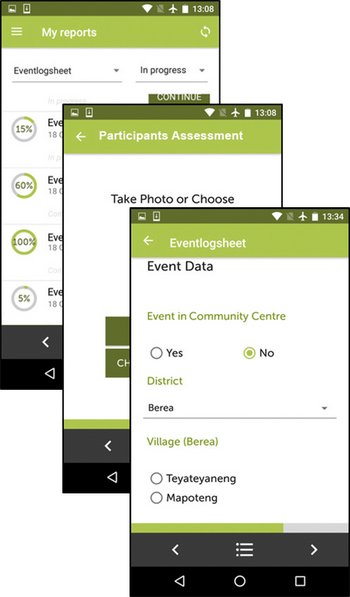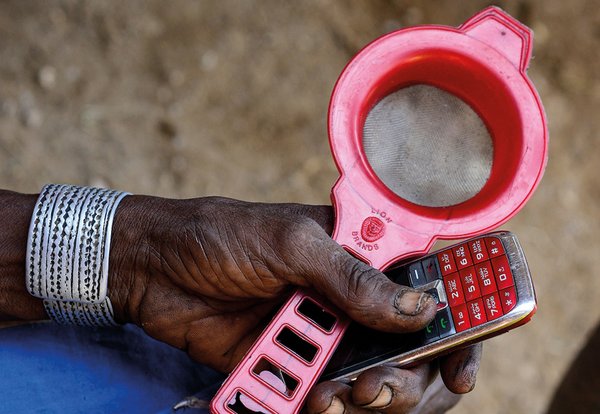 Download this article in magazine layout
Download this article in magazine layout
- Share this article
- Subscribe to our newsletter
More than plug-and-play – digital solutions for better monitoring & evaluation
It is an open secret that many project managers and staff consider M&E a laborious extra burden that keeps them from their actual work – even if they are well aware of its benefits. Many, if not most, of them would agree that monitoring and evaluating their activities’ progress and results is important for informed project steering, accountable reporting and even for convincing public relations. They might also agree that reliably managing and communicating data helps promote co-operation, co-ordination and transparency among projects, partners, donors and beneficiaries. But if the benefits of M&E are known, then where does the apparent reluctance to tap into them come from?
The experience of Mainlevel Consulting in supporting projects to improve their M&E through digital solutions shows that the reasons often come down to the procedures and mechanisms that projects use to operationalise their M&E systems. A common challenge is the lack of reliable data sources or user-friendly tools to collect, transfer and analyse data. This makes data management and reporting a time-consuming and frustrating affair for anyone involved. Fortunately, this is also where digital solutions bear the most potential to support and replace M&E frustrations with motivation.
Reaping digital benefits for M&E
Recent years have seen a rapid spread of digital technologies. More and more people, even in remote areas, own mobile phones giving them unprecedented opportunities to access and share information. This is changing the way sustainable development is informed, mediated and advanced. According to the 2016 World Development Report, digital technologies can make development more inclusive, more efficient and more innovative by facilitating access to information and services, by reducing the cost of economic and social transactions, or by simplifying the upscaling of promising solutions. Projects can greatly benefit from these digital opportunities to improve core M&E processes such as gathering, disseminating and analysing data. For instance, mobile applications can simplify the collection of monitoring data, especially in decentralised projects. For a civic education project in Lesotho, Mainlevel developed a mobile app enabling staff in district centres across the country to collect data on activities via flexible questionnaires (see screenshots). This replaces Word files that were sent via e-mail and manually transferred to Excel. Anyone more comfortable with speaking than writing can use voice-recognition to record texts. In remote areas where network coverage is unstable, staff can rely on the app because it is low on bandwidth and securely stores data on- and offline. Additionally, GPS co-ordinates and images enrich the datasets and make them more accurate.
For instance, mobile applications can simplify the collection of monitoring data, especially in decentralised projects. For a civic education project in Lesotho, Mainlevel developed a mobile app enabling staff in district centres across the country to collect data on activities via flexible questionnaires (see screenshots). This replaces Word files that were sent via e-mail and manually transferred to Excel. Anyone more comfortable with speaking than writing can use voice-recognition to record texts. In remote areas where network coverage is unstable, staff can rely on the app because it is low on bandwidth and securely stores data on- and offline. Additionally, GPS co-ordinates and images enrich the datasets and make them more accurate.
Another good example is online platforms that help projects aggregate and analyse the collected data in real-time. A centrally accessible web portal (see screenshot, below) gives the M&E officer in Lesotho a live overview of all monitoring data as it arrives from the districts, enabling her to extract actionable insights. Data visualisations that reflect the project’s indicators allow her to analyse the project’s pro-gress and to identify potential bottlenecks. The ability to export these visuals makes it easier for her to produce regular status reports. And showcasing the live system to district staff can even increase their motivation for reporting reliably and regularly because they see that headquarters is now able to instantly acknowledge their achievements.
Understand the user – then think digital
These digital solutions benefit the staff in Lesotho because they speak to their needs. For instance, the use of mobile apps makes sense because all project staff have access to smartphones. Other projects, where this may not be the case, would require different solutions. The point is that just by introducing digital solutions, a project will not magically improve its M&E system. This takes more than plug-and-play. Planning officers and project managers need to understand that digital solutions will only be useful if they fit to the project environment and, above all, to the needs and requirements of the people meant to use them.
Even the most sophisticated digital tools for M&E risk failure if introduced based on their technical functions alone. The perspective has to shift from the technology to its users. People are more likely to appreciate digital solutions that meet two basic criteria: firstly, they need to feel useful e.g. because they simplify collecting, analysing or reporting on monitoring data; and secondly, they need to feel easy to use e.g. because they are designed to be intuitive enough not to require lengthy manuals. Therefore, before deciding on any digital solutions, projects need to consult with the people meant to use them and keep them engaged throughout the development process. This gives them the chance to jointly develop a user-friendly digital solution that supports everyone with M&E – and avoid settling on unfitting tools that may end up adding to everyone’s workload rather than relieving it.
Doing digital M&E right
 With all this in mind, is there practical advice that projects can follow to apply digital technologies for improving their M&E systems and processes? The answer is yes – but there are no magic recipes. Our experience points to four ingredients that help doing digital M&E right:
With all this in mind, is there practical advice that projects can follow to apply digital technologies for improving their M&E systems and processes? The answer is yes – but there are no magic recipes. Our experience points to four ingredients that help doing digital M&E right:
- Assess the digital readiness: Digital tools only take effect if they meet the needs, opportunities and limitations of the environment in which they are to be used. It is therefore important to first assess the digital readiness of the project and its context. What skills do people have to operate digital tools? What technical infrastructure is available? What is the mentality towards digital innovation? For instance, a rural project may see potential in introducing a mobile solution to replace paper-based data collection in remote areas. Since people there rely on simple feature phones, the project decides on a text-based system that uses SMS surveys to gather data.
- Develop agile and with the user: To build useful and intuitive digital solutions, the needs and expectations of the users have to be at the heart of the development. Here an agile, user-centred approach helps. For instance, the rural project may decide to establish a web portal to replace Excel sheets for analysing collected data. This portal is built in several iterations – after each one the M&E staff test it and give feedback. As a result, they feel it is tailored to their needs and appreciate that they can use it early on without complex manuals.
- Start small and modular: User-centred development also helps projects identify unforeseen requirements and needs with regard to digital solutions. To be able to accommodate these, projects should start with small-scale, modular pilots instead of largely pre-defined solutions. For instance, the rural project may find that SMS should be used not just for collecting data but also for sharing insights with beneficiaries. The modular pilot makes it easier and less costly for the project to adjust the digital solution – and to bring it to scale eventually.
- Provide training and support: Even if digital solutions are intuitive and easy to use, projects need to ensure that everyone meant to use them has the digital skills to do so. This means that projects need to invest in training measures followed by continuous support. For instance, the rural project may offer training workshops and identify digital ‘champions’ in its team to support colleagues less digitally adept.
The examples show that there is great potential for projects to reap digital benefits for making their M&E systems more efficient, informative and motivating to use. As long as they stick to one central mantra: Before thinking digital – think of the users.
Daniel Brumund is a consultant for digital solutions and communication at Mainlevel Consulting in Berlin/Germany. He advises on strategy and practice of ICTs for M&E and development co-operation.
Contact: daniel.brumund@mainlevel.de





Add a comment
Be the First to Comment